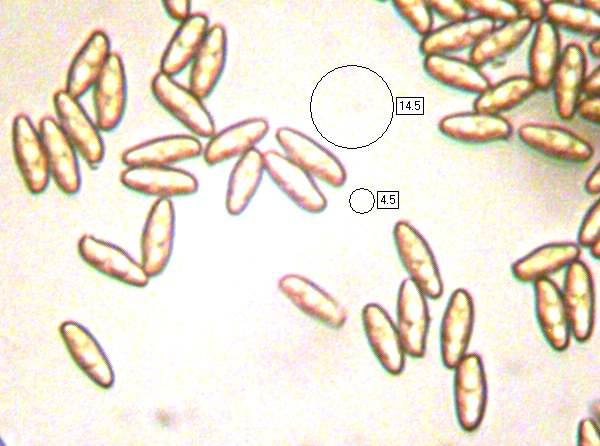Xerocomellus chrysenteron (Bull.) Šutara - Red Cracking Bolete
Phylum: Basidiomycota - Class: Agaricomycetes - Order: Boletales - Family: Boletaceae
Distribution - Taxonomic History - Etymology - Identification - Culinary Notes - Reference Sources
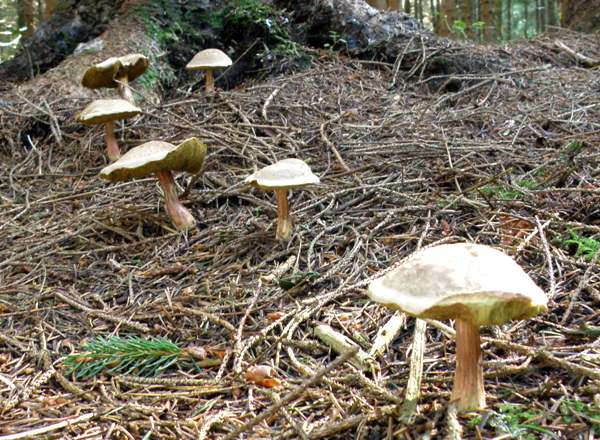
An untidy bolete when mature, and of little culinary interest because of its poor texture, Xerocomellus chrysenteron, the Red Cracking Bolete, can be found in summer and autumn. It is now clear that a complex of species was included under the label 'Red Cracking Bolete' including Xerocomellus truncatus (an American species) and Xerocomellus cisalpinus (which is common throughout most of Europe).
This species, formerly classified as Xerocomus chrysenteron (Bull.) Quél., has been recently moved to the genus Boletus (in the BMS checklist of British fungi).
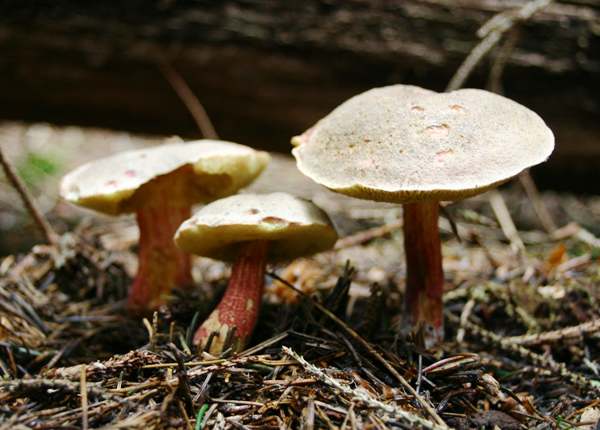
Despite the common name, only a minority of 'Red Cracking Boletes' have caps that crack. (Xerocomellus cisalpinus, in contrast, is very often seen with a red cracked cap!) To separate this apparently rather uncommon bolete from its close lookalikes it is therefore essential to check all of the characters listed. This is a difficult bolete to identify with any certainty, and I am grateful to the experts who have provided help and guidance as I have struggled to untangle it from the many other similar species that occur in the same range of habitats.
Distribution
Xerocomellus chrysenteron is probably an infrequent species in Britain and Ireland as well as on mainland Europe, but because of confusion with other closely-related species historic records may be unreliable.
Taxonomic history
This uncommon bolete (and historically probably misidentified more often than not - I certainly did!) was first described and named in 1789 by the famous French botanist-mycologist Jean Baptiste Francois (Pierre) Bulliard, who initially called it Boletus communis. In 1791 Bulliard changed the specific epithet to chrysenteron, and after various reshuffles of generic/specific name over the succeeding 200 years or so the Red Cracking Bolete is now generally referred to as Xerocomellus chrysenteron, following a 2008 publication by the Czech mycologist Josef Šutara, whose studied in detail morphological character of this and other closely-related boletes - since further supported by DNA studies..
Etymology
The generic name Boletus comes from the Greek bolos, meaning 'lump of clay', while the new genus name Xerocomellus indicates a (rather distant, actually) relationship with the genus Xerocomus. The prefix Xero- means dry.
The specific epithet chrysenteron means 'golden inside' - a reference to the bright yellow flesh of this mushroom.
Identification guide
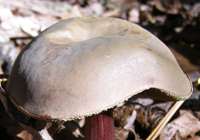 |
CapXerocomellus chrysenteron, the Red Cracking Bolete, has a shallow, convex grey-yellow or brownish cap that sometimes crazes to reveal a thin layer of red flesh below the skin. 4 to 10cm in diameter when fully expanded, the caps have very little substance and the thin flesh blues very slightly when cut. Young specimens can have dark downy caps and might be mistaken for Bay Boletes, Imleria badia. |
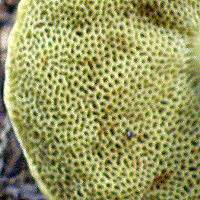 |
Tubes and PoresThe yellow tubes terminate in large, angular pores that are lemon yellow at first but turn a dirty olive yellow as they age. When bruised, the pores of mature specimens slowly turn greenish blue. |
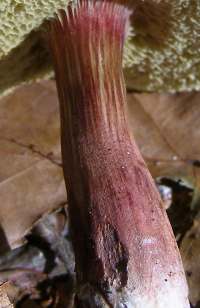 |
StemThe stem of Xerocomellus chrysenteron, which like other Xerocomellus species has no ring, is bright yellow flushed with coral-red fibrils that give it a 'stick of rhubarb' appearance. When cut or eaten by slugs, the stem flesh is reddish just below the cortex (as shown on the left) and cream elsewhere; it does not turn significantly blue - a feature that helps separate Xerocomellus chrysenteron from Xerocomellus cisalpinus, whose stem base turns distinctly blue when it is either cut or bruised. 10 to 15mm in diameter and 4 to 8cm tall, the stem of the Red Cracking Bolete is fairly constant in diameter throughout its length. |
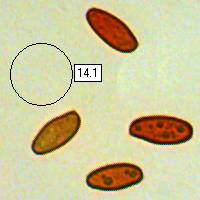 |
SporesSubfusiform, smooth; 12-16.5 x 4.5-7µm. Spore printOlivaceous brown. |
Odour/taste |
Not distinctive. |
Habitat & Ecological role |
This ectomycorrhizal species is often found mainly beneath conifers but perhaps occasionally also with beech trees. |
Season |
Red Cracking Boletes appear mainly from August to November, but occasionally they can be seen much earlier in the year. |
Occurrence |
Uncommon but probably widespread throughout Britain and Ireland, Xerocomellus chrysenteron is reported also from mainland Europe and parts of North America. |
Similar species |
Xerocomellus cisalpinus has a yellow stem flushed red in the lower part and blueing when cut or bruised near the stem base; its spores are finely striated. In the USA a similar bolete, Xerocomellus truncatus, is differentiated from the Red Cracking Bolete only by the microscopic characters of its spores, which as the name suggests are 'truncated'. Pseudoboletus parasiticus (synonyms Xerocomus parasiticus and Boletus parasiticus) has a yellow stem without red fibrils, and it occurs only with the Common Earthball (Scleroderma citrinum) upon which it may be slightly parasitic. |
Culinary Notes
Xerocomellus chrysenteron is generally considered edible if it is cooked thoroughly; however, because of its soggy texture this bolete is not highly regarded as an esculent.
Reference Sources
Fascinated by Fungi, 2nd Edition, Pat O'Reilly 2016, reprinted by Coch-y-bonddu Books in 2022.
British Boletes, with keys to species, Geoffrey Kibby (self published) 3rd Edition 2012
Roy Watling & Hills, A.E. 2005. Boletes and their allies (revised and enlarged edition), - in: Henderson, D.M., Orton, P.D. & Watling, R. [eds]. British Fungus Flora. Agarics and boleti. Vol. 1. Royal Botanic Garden, Edinburgh.
BMS List of English Names for Fungi
Dictionary of the Fungi; Paul M. Kirk, Paul F. Cannon, David W. Minter and J. A. Stalpers; CABI, 2008
Taxonomic history and synonym information on these pages is drawn from many sources but in particular from the British Mycological Society's GB Checklist of Fungi.
Fascinated by Fungi. Back by popular demand, Pat O'Reilly's best-selling 450-page hardback book is available now. The latest second edition was republished with a sparkling new cover design in September 2022 by Coch-y-Bonddu Books. Full details and copies are available from the publisher's online bookshop...
